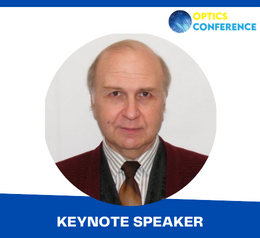Scholars 2nd Edition International Conference on
Optics, Lasers and Photonics
THEME: "A New Era towards Optics, Lasers & Photonics Technologies"
 27-28 Mar 2023
27-28 Mar 2023  Crowne Plaza Ealing, London, UK & Online
Crowne Plaza Ealing, London, UK & Online THEME: "A New Era towards Optics, Lasers & Photonics Technologies"
 27-28 Mar 2023
27-28 Mar 2023  Crowne Plaza Ealing, London, UK & Online
Crowne Plaza Ealing, London, UK & Online 
Donetsk National University, Ukraine
Title: Quantized light-matter coupling in a nonideal polaritonic structure as a system of microcavities containing quantum dots
Vladimir V. Rumyantsev is Chair of the Department of Theory of Complex Systems Dynamic Properties at A.A. Galkin Donetsk Institute for Physics and Engineering. He is Professor of Theoretical Physics and Nanotechnology Department at Donetsk National University. He received PhD in Theoretical Physics (1988) and Dr. Sci. in Condensed Matter Physics (2007). Prof. Rumyantsev has authored/co-authored 4 books, 2 chapters in books and more than 340 scientific publications. He is a member of the American Physical Society as well as Mediterranean Institute of Fundamental Physics (MIFP, Italy).
The important features of photonic structures discussed are related to ‘slow’ light, which is one of the promising fundamental physical phenomena that need to be investigated when designing various quantum optical storage devices. In particular, an effective reduction of the group velocity has been demonstrated in the corresponding optical waveguide resonators, as well as in various types of solid-state semiconductor multilayer structures. The key role in reducing the group velocity in these systems is played by the so-called light and dark polaritons, which are a linear superposition of photonic states of the electromagnetic field and macroscopic (coherent) disturbances of a two-level atomic medium. In atomic systems, the lifetime of polaritons is limited by the lifetime of excited atoms and is usually characterized by nanoscale. The current level of development of nanotechnology and nanophotonics makes it possible to study "slow" light and phase transitions of polaritons by creating an array of connected microcavities containing two-level atoms.
The report proposes a spatially periodic atomic structure - a polariton crystal formed by ensembles of atomic clusters (quantum dots) interacting with a localized electromagnetic field in a tunnel-bound matrix of microcavities. A non-ideal system of this class is considered - a polariton system with a microcavities subsystem containing clusters of impurity quantum dots. It is found that by introducing a defect into a photonic supercrystal, the dispersion of photonic modes can be changed. In this paper, we also consider the effect of uniform elastic deformation on one-dimensional arrays of microcavities with embedded quantum dots. This system combines the advantages of the coupling of quantum dots with photonic modes, and the high sensitivity of the intrinsic optical modes to the applied deformation. Such systems have a high potential for application in optical integrated circuits.